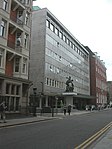Bedford College, London
1849 establishments in EnglandBedford College, LondonEducational institutions disestablished in 1985Educational institutions established in 1849Former colleges of the University of London ... and 4 more
Former women's universities and colleges in the United KingdomRegent's ParkRoyal Holloway, University of LondonUse British English from September 2017

Bedford College was founded in London in 1849 as the first higher education college for women in the United Kingdom. In 1900, it became a constituent of the University of London. Having played a leading role in the advancement of women in higher education and public life in general, it became fully coeducational (i.e. open to men) in the 1960s. In 1985, Bedford College merged with Royal Holloway College, another constituent of the University of London, to form Royal Holloway and Bedford New College. This remains the official name, but it is commonly called Royal Holloway, University of London (RHUL).
Excerpt from the Wikipedia article Bedford College, London (License: CC BY-SA 3.0, Authors, Images).Bedford College, London
Bedford Square, London Bloomsbury (London Borough of Camden)
Geographical coordinates (GPS) Address Website Nearby Places Show on map
Geographical coordinates (GPS)
| Latitude | Longitude |
|---|---|
| N 51.518545 ° | E -0.129481 ° |
Address
Yale University Press
Bedford Square 47
WC1B 3DP London, Bloomsbury (London Borough of Camden)
England, United Kingdom
Open on Google Maps










